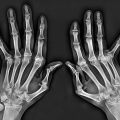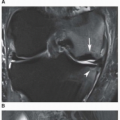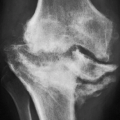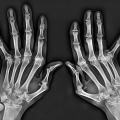Treatment of the Arthritides and Arthropathies
MEDICAL TREATMENT
The treatment of rheumatologic diseases has undergone a revolution in the past decade. In the past, the paradigm for the management of inflammatory arthritides, such as rheumatoid arthritis, psoriatic arthritis, and ankylosing spondylitis, was to treat with nonsteroidal anti-inflammatory drugs (NSAIDs), followed by increasing use of more potent medication; this was often called a pyramid scheme. However, this is no longer the case. The current dogma is to treat patients early and aggressively with disease-modifying drugs and, in particular, to include the use of the biologic drugs such as agents that inhibit tumor necrosis factor (TNF), IL-6, or CD20-bearing B cells. Discussion of these therapies is beyond the scope of this textbook, but it is important to note that the biologic drugs have a significant potential to modify disease, reduce the systemic manifestations, and slow the progression of destructive changes in the joints. They do, however, carry significant side effects and must be monitored on a regular basis. For this reason, we recommend that the use of such drugs be done by rheumatologist and not by family practitioners or internists, unless a rheumatologist concurrently follows the patient. Interestingly, this is likewise the case for patients with gout. In the past, treatment consisted of anti-inflammatory drugs and often the use of allopurinol. However, a whole variety of new drugs have been introduced that modulate different levels of uric acid metabolism, and here again, our recommendation is that such usage should be done by rheumatologists. Treatment for CPPD crystal deposition disease associated with pseudogout syndrome is essentially the same as for gout, including oral administration of colchicine. Unfortunately, the treatment model has not significantly changed for systemic lupus erythematosus (SLE), in which there have been no significant improvements in drugs or drug protocols for more than a decade. Although there are agents that block B-cell activation and have been approved for SLE, they are, for the most part, disappointing. The treatment of first choice for reactive arthritis consists of NSAIDs, such as ibuprofen. Systemic glucocorticoids or intra-articular injections of steroids can also be beneficial. Because reactive arthritis is associated with infection caused by Shigella, Salmonella, Campylobacter, Yersinia, or Chlamydia trachomatis, appropriate antibiotic treatment should be administered if infection is active.
Finally, we note that despite intensive efforts at understanding cartilage repair and new bone formation, the treatment of osteoarthritis has remained unchanged. The major handicap is a late diagnosis of the disease, because majority of the patients present to the medical facilities with the already advanced, nondiagnosed osteoarthritis lasted for years. There are already pathologic changes in cartilage water content and an age-related influence of normal tissue repair. These factors are superimposed, among others, on influence of obesity, prior injury, and poor conditioning. Most patients with osteoarthritis can be managed through nonpharmacological and pharmacological therapy. The former includes education, weight management, bracing, and appropriate exercise with goal to delay the progression of the disease, alleviate symptoms, and improve function. Nutritional supplements such as glucosamine and chondroitin sulfate may be beneficial for some patients. Occasionally, therapeutic ultrasound and pulsed electromagnetic field therapy proved to be helpful. The pharmacological therapy includes nonnarcotic analgesics such as acetaminophen and nonsteroidal anti-inflammatory drugs. The use of opiates is strongly discouraged. Some patients benefit from intra-articular injections of corticosteroids or hyaluronan, particularly for osteoarthritis of the knee. The latter drug produces symptomatic
relief through one or more of a large number of mechanisms. It decreases the sensitivity of pain fibers, enhances proteoglycan synthesis by chondrocytes, reduces quantities and activity of proinflammatory mediators and matrix metalloproteinases, and alters the behavior of immune system cells.
relief through one or more of a large number of mechanisms. It decreases the sensitivity of pain fibers, enhances proteoglycan synthesis by chondrocytes, reduces quantities and activity of proinflammatory mediators and matrix metalloproteinases, and alters the behavior of immune system cells.
The bottom line and importance of these paradigms and treatments are that the improvements in the care of patients with rheumatoid arthritis, psoriatic arthritis, and ankylosing spondylitis have been nothing less than earth shattering, but carry with them an enormous price tag, the potential for drug toxicity, and the recommendation that only rheumatologists prescribe and follow the use of such medications. Clearly the diagnosis becomes essential, and to this end, this textbook that focuses on imaging will provide this important link.
RADIOTHERAPY
Radiotherapy was used in the past in several rheumatologic disorders in an attempt to relieve symptoms of inflammation. In particular, radiotherapy for ankylosing spondylitis was used extensively in the 1950s. With the recognition of significant long-term complications from high doses of radiation, including the development of pulmonary fibrosis, leukemias, lymphomas, osteosarcomas, and other malignant tumors, this approach has generally been abandoned. More recently, radiosynovectomy that involves an intraarticular injection of small radioactive articles became a well-established therapy for arthritic disorders to treat synovitis. Intra-articular radiotherapy using yttrium 90 (Y90) was attempted in patients with rheumatoid arthritis. Some investigators reported promising results after radiation synovectomy for inflamed small joints of the hands injecting under fluoroscopic or sonographic guidance erbium-169 (169Er) citrate colloid. The other radiopharmaceutical used for this purpose included rhenium 186 (186Re) sulfur colloid, lutetium 177 (177Lu)-labeled hydroxyapatite particles, colloidal chromium phosphate (32P), and radioactive colloid gold (198Au). In selected patients with systemic lupus erythematosus and with rheumatoid arthritis, the use of the total lymphoid irradiation as a localized means of immune suppression (TLI) has been studied. In Europe, teleradiotherapy of inflamed joints in the patients with rheumatoid arthritis has been tried, using a 20 MeV linear accelerator delivering a total dose of 20 Gy, without however significant results.
ORTHOPEDIC TREATMENT
Similar modalities as for diagnosis are used for monitoring the results of medical and surgical treatment of arthritis. Because the most effective treatment, particularly when large joints are involved, entails corrective and reconstructive procedures such as femoral or tibial osteotomy or total joint replacement of the hip, knee, ankle, shoulder, or elbow, the orthopedic surgeon follows the postsurgical progress of the patient with sequential radiographic examinations. In osteoarthritis of the hip, the corrective procedures most often performed are varus or valgus osteotomies of the proximal femur to improve the congruence of the articular surfaces and redistribute the stress forces over different areas of the joint. Similarly, a high tibial osteotomy is performed to correct severe varus or valgus deformities in osteoarthritis of the knee, particularly in cases of unicompartmental involvement (Fig. 4.1). The radiographic techniques used in monitoring the outcome of these procedures, which in fact represent
iatrogenic surgical fractures, are similar to those used in evaluating traumatic fractures. As in traumatic fractures, the radiologist also pays attention to similar features, such as bone union, nonunion, or delayed union.
iatrogenic surgical fractures, are similar to those used in evaluating traumatic fractures. As in traumatic fractures, the radiologist also pays attention to similar features, such as bone union, nonunion, or delayed union.
In patients in whom total hip arthroplasties were performed, radiographic scrutiny is also essential. At present, two basic types of hip arthroplasty are used in orthopedic practice: bipolar hip hemiarthroplasty and total hip arthroplasty. The first type is used mainly for patients with fracture of the femoral head and neck and those with advanced femoral head osteonecrosis.
Bipolar prosthesis has a metallic cup the size of the resected femoral head filled with polyethylene, providing an articular cavity to accommodate the metallic femoral head attached to the stem (Fig. 4.2). The principle of this type of construction is that the motion between the metallic femoral head and the inner polyethylene insert reduces the wear of the native acetabulum. Total hip arthroplasty is commonly used in patients with advanced arthritis of the hip joint. The modern systems are modular, meaning that the femoral stem, head, acetabular shell, and liner consist of separate pieces. The prosthetic components, commonly composed of cobalt-chrome alloy or titanium (femoral stem) and metal or ceramic (femoral head), are usually cemented to the bone with polymethylmethacrylate (PMMA) (Fig. 4.3), although cementless fixation is now gaining popularity. The latter
technique is based on the use of a rough or porous surface on the prosthetic parts that enables ingrowth of the bone. A bioactive coating (i.e., hydroxyapatite) can also be used for the same purpose. Acetabular components, which contain a polyethylene liner with or without metal backing, usually have a porous coating over the entire surface of the cup, whereas femoral components can be either partially or fully coated (Fig. 4.4A). Cementless acetabular components are sometimes reinforced with the rim screws or spikes (Fig. 4.4B). Occasionally, so-called hybrid arthroplasties are performed with cementless acetabular and cemented femoral components (Fig. 4.5).
technique is based on the use of a rough or porous surface on the prosthetic parts that enables ingrowth of the bone. A bioactive coating (i.e., hydroxyapatite) can also be used for the same purpose. Acetabular components, which contain a polyethylene liner with or without metal backing, usually have a porous coating over the entire surface of the cup, whereas femoral components can be either partially or fully coated (Fig. 4.4A). Cementless acetabular components are sometimes reinforced with the rim screws or spikes (Fig. 4.4B). Occasionally, so-called hybrid arthroplasties are performed with cementless acetabular and cemented femoral components (Fig. 4.5).
Alternative to conventional total hip arthroplasty, especially in younger patients, metal-on-metal (MOM) hip resurfacing arthroplasty (HRA) has been advocated (Fig. 4.6). There are different types of this prosthesis, but most of them are made from high carbon cobalt-chromium alloys and consist of a femoral component, which can be cemented or noncemented, and an uncemented acetabular component, which achieves primary fixation through press-fit and circumferential fins. The acetabular components are coated using various methods and material providing a bone ingrowth surface at the implant-bone interface to achieve maximum stability. The advantage of this type of arthroplasty include the durability of the prosthetic components, low volumetric wear rate, an increased level of inherent stability using large heads with reduced rate of dislocation, preservation of metaphyseal and diaphyseal bone stock, optimization of stress transfer to the proximal femur, optimal range of movement, and improved biomechanics of the hip joint. The disadvantage of this type of hip arthroplasty is shedding metal particles leading to periprosthetic osteolysis and metallosis with formation of pseudotumors (see text below).
After total hip replacement using cemented components, it is important to evaluate the position of the prosthesis, with particular reference to the degree of inclination of the acetabular component, the position of the stem of the prosthesis (whether it is in valgus, varus, or the neutral position), and
the status of the separated and rejoined greater trochanter, among other features (see Fig. 4.3). Equally important is the evaluation of cement-bone interface to detect the radiolucent area suggestive of prosthesis loosening (see Fig. 4.22). It is important to remember that at the cement-bone interface, a thin fibrous layer may form as response to focal necrosis of osseous tissue because of the heat of the cement polymerization. This radiolucent zone is usually not wider than 2 mm and becomes stable by 2 years after arthroplasty. After total hip arthroplasty using noncemented components (see Fig. 4.4), radiologic evaluation should focus on the interface between the prosthesis and the bone to detect areas of bone resorption (focal osteolysis) associated with endosteal scalloping that may indicate loosening of the prosthesis. Additional abnormalities to look for are progressive subsidence, migration, or tilt of the components. With HRA, there is well-documented risk of femoral neck fracture. Groin pain may occur secondary to impingement of the femoral neck on the acetabular component resulting in femoral neck scalloping. Because the implant consists of a metal-on-metal articulation made from cast cobalt-chromium alloys, the incidents of production of wear particles, and hence the occurrence of metallosis, is increased.
the status of the separated and rejoined greater trochanter, among other features (see Fig. 4.3). Equally important is the evaluation of cement-bone interface to detect the radiolucent area suggestive of prosthesis loosening (see Fig. 4.22). It is important to remember that at the cement-bone interface, a thin fibrous layer may form as response to focal necrosis of osseous tissue because of the heat of the cement polymerization. This radiolucent zone is usually not wider than 2 mm and becomes stable by 2 years after arthroplasty. After total hip arthroplasty using noncemented components (see Fig. 4.4), radiologic evaluation should focus on the interface between the prosthesis and the bone to detect areas of bone resorption (focal osteolysis) associated with endosteal scalloping that may indicate loosening of the prosthesis. Additional abnormalities to look for are progressive subsidence, migration, or tilt of the components. With HRA, there is well-documented risk of femoral neck fracture. Groin pain may occur secondary to impingement of the femoral neck on the acetabular component resulting in femoral neck scalloping. Because the implant consists of a metal-on-metal articulation made from cast cobalt-chromium alloys, the incidents of production of wear particles, and hence the occurrence of metallosis, is increased.
 Figure 4.6 ▪ Total hip resurfacing arthroplasty. A 42-year-old man with osteoarthritis of both hip joints underwent metal-on-metal total resurfacing hip arthroplasties. |
Although two-compartmental and unicompartmental knee arthroplasties are occasionally performed, the most common type is a total knee arthroplasty. This procedure combines resurfacing the femoral, tibial, and patellar articular surfaces by using metal and polyethylene bearing surfaces. The major prosthesis categories include posterior cruciate ligament-retaining, posterior cruciate ligament-substituting or stabilized, unlinked constrained or varus-valgus constrained, and rotating-hinge knee implants. Femoral and tibial components can be either cemented, noncemented, or anchored with the screws. A patellar component invariably consists of high-density polyethylene, which can be metal-backed. Modern three-part (three-compartmental) condylar cemented nonconstrained arthroplasty is performed using metal femoral component, which resurfaces both condyles and the trochlear notch, and a tibial component, which consists of a metal-backed polyethylene tray that articulates with the femoral component (Fig. 4.7). Some tibial components may contain a locking-mechanism clip that locks the tibial polyethylene tray into the tibial base plate. Occasionally, femoral and tibial components can include varying length stems that supplement prosthesis fixation, and tibial component may be augmented with prominent pegs for additional stability. Fully constrained rotating-hinge total knee arthroplasty is usually performed for revision of failed nonconstrained knee arthroplasty and in patients with ligament deficiency, severe bone loss, or severe knee joint instability (Fig. 4.8). This type of implant allows the flexion-extension movement combined with rotation of the femur on the tibial component or with rotation of the tibial polyethylene liner on the metal tibial tray, thus allowing a more physiologic range of motion and reducing the stress transfer to the bone-prosthesis interface compared with the old fixed-hinge models. After a total knee arthroplasty with a condylar type of prosthesis, it is important to evaluate the position of the tibial component relative to the tibial shaft, as well as the axial alignment and the status of the methylmethacrylate fixation
of the components (see Fig. 4.7). The tibial component should be aligned perpendicular to the long axis of the tibia on the anteroposterior view of the knee and perpendicular or in slight (up to 6 degrees) flexion on the lateral view. The anterior bracket (flange) of the femoral component should be flushed with the anterior femoral cortex.
of the components (see Fig. 4.7). The tibial component should be aligned perpendicular to the long axis of the tibia on the anteroposterior view of the knee and perpendicular or in slight (up to 6 degrees) flexion on the lateral view. The anterior bracket (flange) of the femoral component should be flushed with the anterior femoral cortex.
Unicompartmental arthroplasty is performed for isolated unicompartmental osteoarthritis, usually in the medial or lateral compartment (Fig. 4.9), although patellofemoral unicompartmental arthroplasty is also occasionally performed (Fig. 4.10).
Total ankle arthroplasty devices incorporate two basic designs: three-component (mobile-bearing) and two-component (fixed-bearing) types. Three-component types are characterized by separate tibial and talar components separated by a fully conforming mobile polyethylene spacer. Two-component types have only a single partially conforming articulation between the tibial and talar components, with the polyethylene spacer fixed to the tibial component. Recently, third-generation ankle implants became increasingly favored over first- and second-generation prostheses, which were cemented and constrained, hence leading to a higher failure rates. The most popular among the third-generation implants is the INBONE prosthesis, a fixed-bearing design with a modular system for both the tibial and talar components (Fig. 4.11A, B). Another popular implant
is a Zimmer third-generation trabecular metal prosthesis (Fig. 4.11C, D). After total ankle arthroplasty, in addition to assessing the position and alignment of the prosthetic parts, attention should be paid to the possible subsidence of the talar component, which should not exceed 5 mm, best evaluated on the lateral view of the ankle. Furthermore, syndesmotic fusion (if performed) and status of adjacent osseous structures should be evaluated.
is a Zimmer third-generation trabecular metal prosthesis (Fig. 4.11C, D). After total ankle arthroplasty, in addition to assessing the position and alignment of the prosthetic parts, attention should be paid to the possible subsidence of the talar component, which should not exceed 5 mm, best evaluated on the lateral view of the ankle. Furthermore, syndesmotic fusion (if performed) and status of adjacent osseous structures should be evaluated.
 Figure 4.10 ▪ Unicompartmental knee arthroplasty. Anteroposterior (A) and lateral (B) radiographs of the left knee show femoropatellar unicompartmental arthroplasty. |
After a total shoulder arthroplasty, whether conventional (Fig. 4.12) or the one using reverse (Delta or Aequalis) shoulder prosthesis (Fig. 4.13), alignment of the prosthetic components and metal-cement and cement-bone interface must be evaluated. Reverse shoulder arthroplasty makes use of a semiconstrained prosthesis that comprises a humeral component, lateralized polyethylene insert, glenosphere, and metaglene, consisting of a base plate that is secured by locking and nonlocking screws to the native glenoid. The humeral component consists of a metal stem that is monoblock or modular and a cup-shaped proximal portion. All humeral components are cemented. With the reverse shoulder arthroplasty, radiologic evaluation should include the position of the glenosphere, which should be flush with the glenoid, and the humeral component that should be centered on the glenosphere proximally and centered within the humeral shaft distally. In addition, the position of the anchoring screws within the scapula, relationship of the humeral component to the scapula, and status of supporting bone should be evaluated. In particular, the inferior border of the glenoid should be examined for erosions and heterotopic ossifications and one should look for unique for this prosthesis complication such as notching of the inferior scapula by the humeral component, and acromial stress fractures.
There are three basic types of total elbow arthroplasty: nonconstrained or resurfacing elbow arthroplasty, semiconstrained elbow arthroplasty, and constrained elbow arthroplasty (Fig. 4.14). In the first type, the prosthesis consists of two separate metal components, humeral and ulnar, which articulate by a high-density polyethylene component. The major complication with this implant is subluxation and dislocation. The semiconstrained prosthesis consists of titanium or cobalt-chromium ulnar and humeral stems that are linked by a pin and bushing, which consists of a polyethylene ring in between the metal components to reduce friction. Constrained elbow prosthesis consists of rigid hinges, constructed with either metal-on-metal or metal and high-density polyethylene parts connected through either a bushing or a separate polyethylene piece that links the humeral and ulnar components. The radial head is commonly resected proximally to the annular ligament. Radiologic evaluation focuses on emerging complications, such as heterotopic ossifications, perihardware lucency indicative of loosening (the humeral component is more prone to this complication), periprosthetic fracture, subluxation or dislocation of the prosthesis, wear and breakdown of bushing, and hardware fracture.
 Figure 4.11 ▪ Total ankle arthroplasty. Anteroposterior (A) and lateral (B) radiographs of the left ankle show intramedullary fixation total INBONE ankle prosthesis. The noncemented prosthetic components made from a titanium alloy and incorporating a cobalt-chrome polyethylene articulation are porous coated for bone ingrowth. Anteroposterior (C) and lateral (D) radiographs of the right ankle of another patient show a third-generation Zimmer trabecular metal total ankle prosthesis. Note status post fibular osteotomy with a side plate and screws fixation.
Stay updated, free articles. Join our Telegram channel
Full access? Get Clinical Tree
 Get Clinical Tree app for offline access
Get Clinical Tree app for offline access

|













